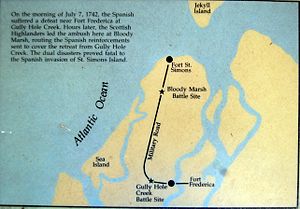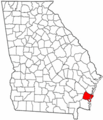Battle of Bloody Marsh facts for kids
Quick facts for kids Battle of Bloody Marsh |
|||||||
|---|---|---|---|---|---|---|---|
| Part of the Invasion of Georgia, War of Jenkins' Ear | |||||||
 A Map of the Bloody Marsh area as it was in 1742 (north is down) |
|||||||
|
|||||||
| Belligerents | |||||||
| Commanders and leaders | |||||||
| Strength | |||||||
| 650 regulars, militia & Native Americans | 150-200+ regulars | ||||||
| Casualties and losses | |||||||
| light casualties | 200 killed | ||||||
The Battle of Bloody Marsh happened on July 7, 1742. It was a fight between Spanish and British forces. The battle took place on St. Simons Island in the Province of Georgia. The British won this important battle.
This battle was part of a bigger conflict called the War of Jenkins' Ear. The main goal was to control the British forts at Fort Frederica and Fort St. Simons. These forts were important for controlling sea routes and inland waters. After the British victory, Georgia officially owned St. Simons Island. Today, it is part of the U.S. state of Georgia. The British also won another battle on the same day, called the Battle of Gully Hole Creek.
Contents
Why the Battle Happened
Setting Up Georgia's Defenses
James Oglethorpe led the effort to create the Georgia colony for Great Britain. He chose Savannah as the main port. In the 1730s, Spain and Great Britain argued over the border between Georgia and La Florida. Spain had several settlements and forts there.
Because of the threat of a Spanish attack, Oglethorpe wanted to make his southern defenses stronger. He chose St. Simons Island as the spot for a new town and fort. In 1734, Oglethorpe convinced the British Parliament to pay for soldiers at the fort.
Building Frederica and Forts
Many colonists were recruited to settle St. Simons Island. They arrived in early 1736. Some went to the mainland, while others traveled by small boats called periaguas to St. Simons Island. There, they started the town of Frederica. The town and its fort were built on the Frederica River. This location helped control boats coming from both directions.
In 1737, Oglethorpe went back to England. He got more money and permission to raise a group of soldiers. He became the commander of all British forces in South Carolina and Georgia. Oglethorpe also brought a group of Scots from Inverness to settle at Darien. These men formed a military group known as the Highland Independent Company.
Two forts were built about five miles apart on St. Simons Island. A road called Military Road connected them. This road was used to supply the soldiers at Fort Frederica and the settlers nearby.
The War of Jenkins' Ear
The battles on St. Simons Island happened after Spain invaded. They were part of the War of Jenkins' Ear, which lasted from 1739 to 1748. The war got its name from an event in 1731. A Spanish group boarded a British ship, the Rebecca, off the Florida coast. They found that its captain, Robert Jenkins, was smuggling. A Spanish officer cut off one of Jenkins' ears.
Even though this incident was old, Parliament used it in 1739 to get public support for a war. But the real reasons for the war were about trade and land between Britain and Spain. Great Britain declared war on Spain on October 30, 1739.
The Invasion and Battles
Spanish Invasion
Spanish governor Don Manuel de Montiano led the invasion force. Some say he had between 4,500 and 5,000 men. About 1,900 to 2,000 of these were ground troops. Oglethorpe's forces were much smaller, with fewer than 1,000 soldiers, militia, and Native American allies.
On July 5, 1742, Montiano landed nearly 1,900 men from 36 ships near Gascoigne Bluff. This was close to the Frederica River. Oglethorpe knew the Spanish had more soldiers. He decided to leave Fort St. Simons before the Spanish could attack it. He ordered his small group of soldiers, called a garrison, to damage the cannons and the fort. This way, the Spanish could not use them fully. The Spanish took over the damaged fort the next day. They used it as their base on the island.
Battle of Gully Hole Creek
After landing their troops and supplies, the Spanish started exploring beyond their camp. They found the road between Fort St. Simons and Fort Frederica. But they thought it was just a small farm road. On July 7, the Spanish sent about 115 men to explore the road. This group was led by Captain Sebastian Sanchez.
Near Fort Frederica, Sanchez's group met Oglethorpe's soldiers, led by Noble Jones. The British quickly defeated the Spanish. They killed or captured almost a third of their soldiers. Oglethorpe's forces then chased the retreating Spanish along Military Road. When Spanish prisoners told them that a larger Spanish force was coming, Oglethorpe left to get more soldiers.
Battle of Bloody Marsh
The British soldiers who were chasing the Spanish had a small fight. Then they pulled back when more Spanish soldiers appeared. When the British reached a bend in the road, they hid in a semi-circle shape behind trees and palmettos. They waited for the Spanish to come closer.
The Spanish soldiers stopped, put down their weapons, and started to cook dinner. They thought they were safe because they had the marsh on one side and the forest on the other. But the British forces opened fire from behind the trees and bushes. They fired many shots, catching the Spanish by surprise.
About 200 Spanish soldiers were killed in this attack. The fighting at Bloody Marsh was very intense. The battle got its name from the idea that the marsh turned red with the blood of the dead Spanish soldiers. The ground was covered with bodies. Some Spanish officers tried to get their soldiers to fight back, but the Spanish soldiers panicked and ran away. The Spanish commander, Barba, was captured after being badly wounded.
This battle stopped the Spanish advance. It was a very important victory for the British. Oglethorpe was given credit for the win, even though he arrived after the fighting had finished.
After the Battle
Oglethorpe kept trying to push the Spanish off the island. A few days later, he learned that a French soldier had left the British side and gone to the Spanish. Oglethorpe was worried that this deserter might tell the Spanish how few British soldiers there were.
So, Oglethorpe came up with a clever plan. He spread out his drummers to make it sound like a much larger army was coming. He also wrote a letter to the deserter, pretending the Frenchman was a spy for the British. The letter said the man should keep telling his stories until Britain could send more men. Oglethorpe made sure a Spanish prisoner carried this letter to the Spanish officers. Just as Oglethorpe hoped, the Spanish believed the letter and quickly executed the Frenchman.
Soon after, British ships arrived. This made the Spanish think that more British soldiers were coming. Because of this, the Spanish left St. Simons Island on July 25. This was their last attempt to invade colonial Georgia.
The End of the War
In the months that followed, Oglethorpe thought about attacking Florida. But the war's focus had moved from America to Europe. It was hard to get weapons, supplies, and soldiers. The area then settled into a quiet peace, with only small fights now and then.
Oglethorpe later became a general. Around 1744, he left Georgia and went back to Britain. He married a wealthy woman and lived in Britain for the rest of his life. The Treaty of Aix-la-Chapelle ended the war in 1748. This treaty officially recognized Georgia as a British colony. Spain formally agreed to this in the Treaty of Madrid in 1750. Georgia's position was made even stronger in 1763. That's when Spain gave Florida to Britain in a land exchange as part of the Treaty of Paris, which ended the Seven Years' War.
The Wormsloe Plantation in Savannah celebrates the War of Jenkins' Ear every year.
Images for kids
-
Bloody Marsh plaque, July 7, 1742 (Old Style)
-
Castillo de San Marcos in St. Augustine, a Spanish stronghold.
See also
 In Spanish: Batalla de Bloody Marsh para niños
In Spanish: Batalla de Bloody Marsh para niños









